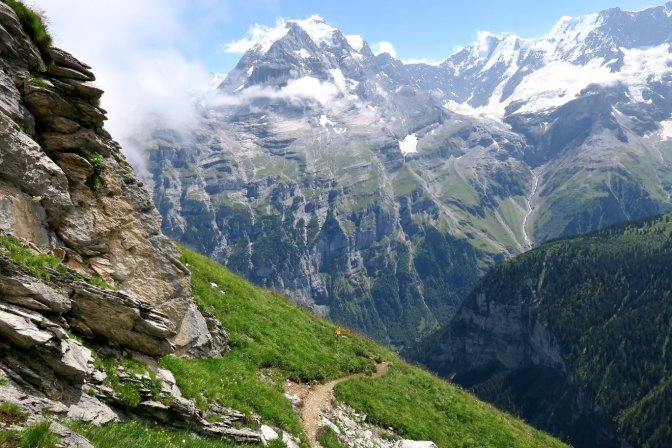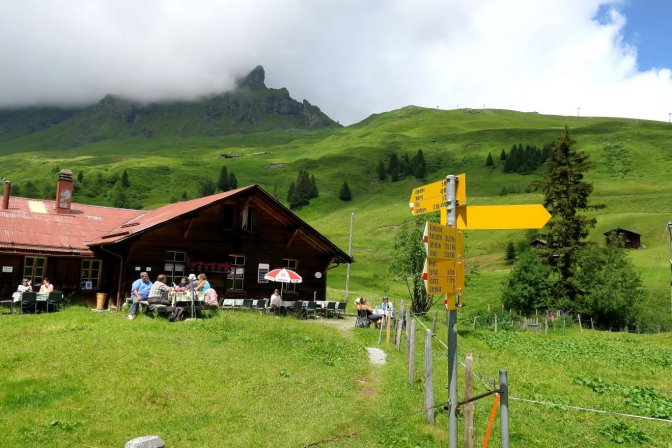Standing majestically on the west side of the exquisite Lauterbrunnen valley (my favorite cathedral) are three stalwarts of the Swiss identity, an iconic trio of Alpine peaks whose names probably need no introduction: Eiger, Mönch, and Jungfrau. The Jungfrau is the tallest of the three and gets the most attention from tourists who can drop 160 euros or so to ride a train to a viewing station near the summit. This area of the Swiss Alps is called the Bernese Oberland, but a more casual name used around this trifecta is the Jungfrau Region.
While these mountains have stood here for tens of thousands of years (? – any geologists may step in at any time), the first recorded names of these mountains are only known for maybe a couple hundred. And while mountains don’t need names to promote their strength and dominance over the earth’s skyline, how the names have changed from the original ones to the current would probably give these mighty towers an identity crisis. In addition, if they had the average mentality of the current American (me included), they’d probably take offense to their names and think the whole silly legend that has sprung up around them is politically incorrect. The names as they stand now in physical order that they are aligned are Eiger (Ogre), Mönch (Monk), and Jungfrau (Virgin/Maiden). The legend is that the Monk is perpetually standing between the sex-starved Ogre and the beautiful virgin – as if women are weak and can’t defend themselves and religion or religious authority are the protectors of virtue – not to mention being called an Ogre. You can see what I mean that if these three were in the Colorado Rockies, there’d be changes coming, no doubt. But the legend gives something shallow for tour guides or guidebooks to mention to give the impression of history.
During my trip to Switzerland last week, I was looking forward to viewing these three mountains in a panoramic way during a hike down from the Schilthorn, which is a mountain peak on the opposite side (eastern side) of Lauterbrunnen Valley. But rather than look at these three divine creations with a kitschy legend clanking around in my head like cheap souvenirs, I took a few moments and searched the dusty Google library. Although there are variances in theories, the origin of Eiger is not the word for Ogre but for high peak or sharp peak, Mönch probably originated from Müncheberg because the mountain stands above Münche or meadows, and Jungfrau was Jungfrauenberge given by Augustinian nuns from Interlaken who owned grazing land high in this mountain. The one thing that is for sure is that the names have been twisted into a sick legend to grab the attention of the tourist. Note the sarcasm. But imagining a simpler time when nuns in the area had dairies and were struggling to survive in this rugged landscape without modern technology and unknowingly helping to create the modern image of the Alpine Swiss culture, and then possibly looking fondly on these three mountains and giving them true meaningful names makes for a better connection with these mountains, wouldn’t you agree?

To get to the top of the Schilthorn, it is easiest to start from Stechelberg cable car station which is a short drive down the valley from Lauterbrunnen. From this station, a cable car takes you to Mürren, where you will change over to another cable car headed to Birg/Schilthorn. Traveling the mountains by cable car or cog railway is not cheap. A full roundtrip fare for an adult from Stechelberg to Schilthorn costs 102 swiss francs (about $105). However, if you catch it before 08:55 in the morning, it only costs 82 swiss francs. What I didn’t know at the time is that I could’ve saved a couple swiss francs if I had bought the brunch buffet inclusive in my ticket. At the top of the Schilthorn is a revolving restaurant with an all you can eat breakfast and lunch buffet where gluttons can stuff themselves with breakfast until they change the buffet at lunch time and then stuff themselves even more until 2:00pm all for the price of about 28 swiss francs – as if anyone is going up there to sit around and eat for five hours. If you buy the buffet inclusive with the ticket, it is 24. Either way, it is overpriced, but for the sake of Dionysius, bottomless cava is always available. The wait staff will try to persuade you to stick around and eat until 2:00pm, but my daughter and I had better things to do, and that was to hike down to one of our favorite Alpine villages, Gimmelwald, and along the way say hello to the Eiger, Mönch, and Jungfrau. Trust me, without clouds, these three are able to keep their eyes on everything you do the entire way down. My daughter and I stepped out into the 45F air, took our first hesitant steps down the loose shale-like stones along a path from the top, and began our descent from 2970m (9744ft).

The first stop was just a short distance down the initial ridge at a rocky outcrop with great views of the landscape below us. The Birg cable car station sat perched off to the distant left peaking out of the low hung clouds. The Wasenegg ridge was partially hidden underneath an increasing flow of clouds coming up from the valley. But there, there right in front of us still clearly visible stood our audience on this day, like three guardians demanding respect and promising a fantastic hike in return.

During the time we sat on that rocky outcrop, the clouds really started to accumulate. The hike down to Birg took us thru the only patches of snow that we would encounter and part of it was completely fogged over. It was actually quite an easy section and one particular spot screamed photo opportunity. And we took it.

After Birg, it was a descent into the thickest fog of the day. I could hear the chit chat from a tour group getting off at Birg and heading our direction. I was determined not to spend any part of this hike playing hop scotch with a noisy group of tourists so I urged us quickly to a small lake, the Grauseeli, for a quick picture and then onwards. At that moment, a small opening formed in the clouds above.

As we started zig-zagging down the mountain from there, I noted that the tour group had stopped at the lake and were fortunately not proceeding any further. After several switchbacks, the trail crosses over to the Wasenegg ridge. During our descent until this point, the three mountains were not visible due to the clouds. Only as we completed the switchbacks did the clouds part and reveal the proud Jungfrau, as if the heavens wanted us to see the strength of this woman, who doesn’t need the intercession of the monk and certainly has no fear of the ogre.

The Wasenegg ridge brought us in contact with a herd of cows. I have a soft spot for these timid creatures especially when they are grazing high in the Alps and swinging those colorful bells. There is something perfect about standing in the Alps and hearing nothing but wind and the clink of cow bells.

One thing you will note about the trails here are that they are well marked. You will see both painted symbols on rocks (usually a red and white flag symbol) and signs such as these at each intersection. This sign was just after the cows and at this moment, we had two directions to choose from. One towards Schiltalp and the other towards Bryndli. I had read that the Bryndli direction was more dangerous and it was necessary to use a rope to follow a knifes-edge path between two steep drop-offs. Well the rope exists as does the two steep drop-offs but the path is really not that narrow and quite easy.


Bryndli was one of the most beautiful locations on the entire hike. After curving around the small peak, the view was amazing. And there still beating away the clouds was Jungfrau. Mönch and Eiger were having less luck.

From this point on, it was a steady diet of downhill. It was at this time I recalled quite clearly my two recently purchased hiking sticks sitting in the backseat of my rental car in the Stechelberg parking lot. We weaved down to the small outpost call Spielbodenalp which boasts an honesty restaurant, meaning that it’s help yourself to the beer and snacks and leave money in the pot. Unfortunately at this moment I realized an important rule of hiking the Swiss Alps – take some francs.

The final stretch of the hike brought us below the tree line thru a forest of knee-jamming descents until opening up to the glorious vista of our destination – the fairytale Alpine village of all Alpine villages – Gimmelwald.

Gimmelwald is not like it’s more commercial siblings, neighboring Mürren or Wengen across the valley. The only businesses to be found here are a hostel, some B&B’s, and a couple honesty shops. Otherwise these are real Swiss farmers doing real Swiss things. Flower boxes prevail, and there is nowhere to hide from the sweet smell of Alpine manure. I will save my love for Gimmelwald for another post. For now though, let’s proceed directly to the hostel for a meal and drink to celebrate our descent.
Coming to Switzerland, I had no misconception that this was going to be a bonanza for drink pilgimages. It is not a country or at least Lauterbrunnen is not a region renowned for it’s beer culture. On any beer list in the area, you will see mainly Rugenbräu, Feldschlösschen, and a few München weiss biers. To be honest, I had no expectation of adding any new beers to Untappd. To my surprise, the hostel restaurant has been host to a small microbrewery for the last couple years. The current bottled batch is called Schwarz Mönch, a dark flavorful ale in the porter/stout family. Frankly, it was the best beer I had in Switzerland, and a great way to conclude a hike and honor the Swiss trio of monumental mountains – the High Peak, the Mountain over Meadows, and the blessed Jungfrau.


Very nice!!!
LikeLiked by 1 person